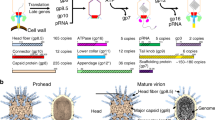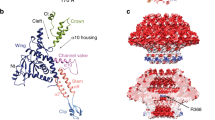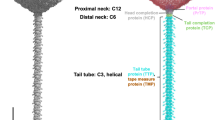Abstract
Bacteriophage T4 is one of the most complex viruses. More than 40 different proteins form the mature virion, which consists of a protein shell encapsidating a 172-kbp double-stranded genomic DNA, a ‘tail,’ and fibers, attached to the distal end of the tail. The fibers and the tail carry the host cell recognition sensors and are required for attachment of the phage to the cell surface. The tail also serves as a channel for delivery of the phage DNA from the head into the host cell cytoplasm. The tail is attached to the unique ‘portal’ vertex of the head through which the phage DNA is packaged during head assembly. Similar to other phages, and also herpes viruses, the unique vertex is occupied by a dodecameric portal protein, which is involved in DNA packaging.
Similar content being viewed by others
Author information
Authors and Affiliations
Corresponding author
Additional information
Received 18 February 2003; received after revision 16 April 2003; accepted 9 May 2003
Rights and permissions
About this article
Cite this article
Leiman, P.G., Kanamaru, S., Mesyanzhinov, V.V. et al. Structure and morphogenesis of bacteriophage T4. CMLS, Cell. Mol. Life Sci. 60, 2356–2370 (2003). https://doi.org/10.1007/s00018-003-3072-1
Issue Date:
DOI: https://doi.org/10.1007/s00018-003-3072-1




